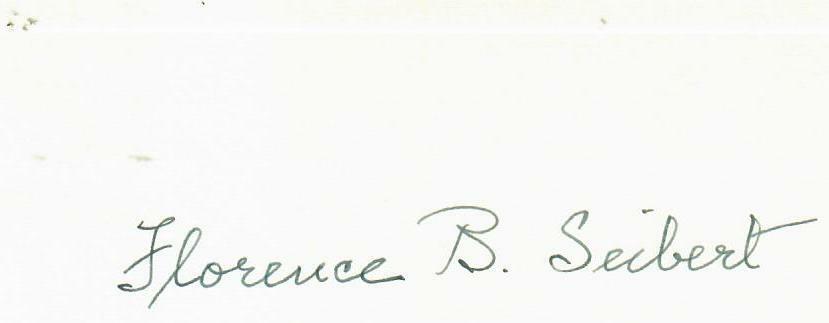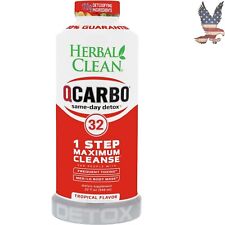"Purified Protein Derivative" Florence Seibert Signed 3.25X5.5 Card For Sale

When you click on links to various merchants on this site and make a purchase, this can result in this site earning a commission. Affiliate programs and affiliations include, but are not limited to, the eBay Partner Network.
"Purified Protein Derivative" Florence Seibert Signed 3.25X5.5 Card:
$199.99
Up for sale "Purified Protein Derivative" Florence B Seibert Signed 3.25X5.5 Card.
ES-1747
Florence Barbara Seibert (October
6, 1897 – August 23, 1991) was an American biochemist. She is best known for identifying the active agent
in the antigen tuberculin as a protein, and subsequently for isolating a pure form of
tuberculin, purified protein
derivative (PPD), enabling the development and use of a
reliable TB test. Seibert has
been inducted into the Florida Women's Hall of
Fame and the National Women's Hall of
Fame. Seibert was born on October 6, 1897, in Easton, Pennsylvania, to
George Peter Seibert and Barbara (Memmert) Seibert. At age three, Florence
contracted polio. She had to wear leg braces and walked with a limp throughout
her life. As a teenager, Seibert is reported to have read biographies of famous
scientists which inspired her interest in science. Seibert did her
undergraduate work at Goucher College in Baltimore, graduating Phi Beta Kappa in 1918. She and one of her chemistry
teachers, Jessie E. Minor, did war-time work at the Chemistry Laboratory of the
Hammersley Paper Mill in Garfield, New Jersey. Dr. Seibert earned her Ph.D. in
biochemistry from Yale University in
1923. At Yale she studied the intravenous injection of milk proteins under the direction of Lafayette Mendel. She developed a method to prevent
these proteins from being contaminated with bacteria. She was a Van Meter Fellow from 1921 - 1922 and an
American Physiological Society Porter Fellow from 1922 - 1923, both at Yale
University. In 1923 Seibert worked as a postdoctoral fellow at the Otho S.A.
Sprague Memorial Institute at the University of Chicago. She
was financed by the Porter Fellowship of the American Philosophical
Society, an award that was competitive for both men and women. She
went on to work part-time at the Ricketts Laboratory at the University of
Chicago, and part-time at the Sprague Memorial Institute in Chicago.
In
1924, she received the University of Chicago’s Howard Taylor Ricketts Prize for
work she began at Yale and continued in Chicago. At Yale she reported a curious
finding: intravenous injections often caused fever in patients. Dr. Seibert
determined that the fevers were caused by toxins produced by the bacteria. The
toxins were able to contaminate the distilled water when spray from the boiling
water in the distillation flask reached the receiving flask. Seibert
invented a new spray-catching trap to prevent contamination during the
distillation process. She published her pyrogen-free process in the American
Journal of Physiology. It was subsequently adopted by the Food and Drug
Administration, the National Institutes of
Health, and various pharmaceutical firms. She was further
recognized in 1962 with the John Elliot Memorial Award from the American
Association of Blood Banks for her work on pyrogens. Seibert
served as an instructor in pathology from 1924-28 at the University of Chicago and
was hired as an assistant professor in biochemistry in 1928. In 1927, her
younger sister Mabel moved to Chicago to live and work with her, employed
variously as her secretary and her research assistant. During
this time, she met Dr. Esmond R. Long MD PhD, who was working on tuberculosis.
In 1932 she agreed to relocate, with Long, to the Henry Phipps Institute at
the University of Pennsylvania.
He became professor of pathology and director of laboratories at the Phipps
Institute, while she accepted a position as an assistant professor in
biochemistry. Their goal was the development of a reliable test for the
identification of tuberculosis. The previous tuberculin derivative, Koch's substance, had produced false negative results in
tuberculosis tests since the 1890s because of impurities in the material. With
Long's supervision and funding, Seibert identified the active agent in
tuberculin as a protein. Seibert spent a number of years developing methods for
separating and purifying the protein from Mycobacterium tuberculosis,
obtaining purified protein
derivative (PPD) and enabling the creation of a reliable test
for tuberculosis. Her first publication on the purification of tuberculin
appeared in 1934. Some sources credit her with successfully isolating the
tuberculosis protein molecule during 1937–38, when she visited the University of Uppsala, Sweden, as a Guggenheim fellow to
work with Nobel-prize winning protein scientist Theodor Svedberg.[5] She developed methods for derivative using filters of porous
clay and nitric-acid treated cotton. In 1938, she was awarded the Trudeau
Medal of the National Tuberculosis Association. In the 1940s, Seibert's
purified protein derivative (PPD) became a national[12] and international standard for
tuberculin tests. In 1943, Seibert received the first Achievement Award of University Women. She remained at the Henry Phipps
Institute at the University of Pennsylvania from
1932 to 1959. She was an assistant professor from 1932-1937, an associate
professor from 1937-1955, a full professor of biochemistry from 1955-1959, and
professor emeritus as of her official retirement in 1959.

Related Items:
"Purified Protein Derivative" Florence Seibert Signed 3.25X5.5 Card
$139.99
QCarbo32 Detox Drink Tropical Flavor 32 Fl Oz Same-Day Premium Cleanse Pack of 1
$82.79


